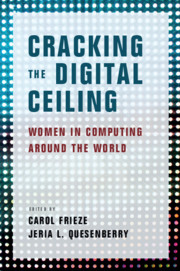16 results
Acknowledgments
-
- Book:
- Cracking the Digital Ceiling
- Published online:
- 10 October 2019
- Print publication:
- 24 October 2019, pp xii-xii
-
- Chapter
- Export citation
Copyright page
-
- Book:
- Cracking the Digital Ceiling
- Published online:
- 10 October 2019
- Print publication:
- 24 October 2019, pp iv-iv
-
- Chapter
- Export citation
Index
-
- Book:
- Cracking the Digital Ceiling
- Published online:
- 10 October 2019
- Print publication:
- 24 October 2019, pp 343-346
-
- Chapter
- Export citation
Contributors
-
- Book:
- Cracking the Digital Ceiling
- Published online:
- 10 October 2019
- Print publication:
- 24 October 2019, pp ix-xi
-
- Chapter
- Export citation
Part III - Cultural Perspectives from the United States and Europe
-
- Book:
- Cracking the Digital Ceiling
- Published online:
- 10 October 2019
- Print publication:
- 24 October 2019, pp 119-260
-
- Chapter
- Export citation
Part IV - Cultural Perspectives from Asia-Pacific
-
- Book:
- Cracking the Digital Ceiling
- Published online:
- 10 October 2019
- Print publication:
- 24 October 2019, pp 261-323
-
- Chapter
- Export citation
Contents
-
- Book:
- Cracking the Digital Ceiling
- Published online:
- 10 October 2019
- Print publication:
- 24 October 2019, pp v-viii
-
- Chapter
- Export citation
Appendix 1.2 - Country Scores on Explanatory Variables
- from 1 - An Inegalitarian Paradox
-
- Book:
- Cracking the Digital Ceiling
- Published online:
- 10 October 2019
- Print publication:
- 24 October 2019, pp 40-45
-
- Chapter
- Export citation
Introduction
-
- Book:
- Cracking the Digital Ceiling
- Published online:
- 10 October 2019
- Print publication:
- 24 October 2019, pp 1-22
-
- Chapter
-
- You have access
- HTML
- Export citation
Notes
-
- Book:
- Cracking the Digital Ceiling
- Published online:
- 10 October 2019
- Print publication:
- 24 October 2019, pp 337-342
-
- Chapter
- Export citation
10 - An Interview with Dr. Sue Black, OBE, Computer Scientist and Computing Evangelist
- from Part III - Cultural Perspectives from the United States and Europe
-
-
- Book:
- Cracking the Digital Ceiling
- Published online:
- 10 October 2019
- Print publication:
- 24 October 2019, pp 183-202
-
- Chapter
- Export citation
Part I - Global Perspectives
-
- Book:
- Cracking the Digital Ceiling
- Published online:
- 10 October 2019
- Print publication:
- 24 October 2019, pp 23-72
-
- Chapter
- Export citation
Part II - Regional Perspectives
-
- Book:
- Cracking the Digital Ceiling
- Published online:
- 10 October 2019
- Print publication:
- 24 October 2019, pp 73-118
-
- Chapter
- Export citation
Conclusion
-
- Book:
- Cracking the Digital Ceiling
- Published online:
- 10 October 2019
- Print publication:
- 24 October 2019, pp 324-336
-
- Chapter
- Export citation
Appendix 1.1 - Zero-Order Correlations for 50 Countries
- from 1 - An Inegalitarian Paradox
-
- Book:
- Cracking the Digital Ceiling
- Published online:
- 10 October 2019
- Print publication:
- 24 October 2019, pp 38-39
-
- Chapter
- Export citation

Cracking the Digital Ceiling
-
- Published online:
- 10 October 2019
- Print publication:
- 24 October 2019



